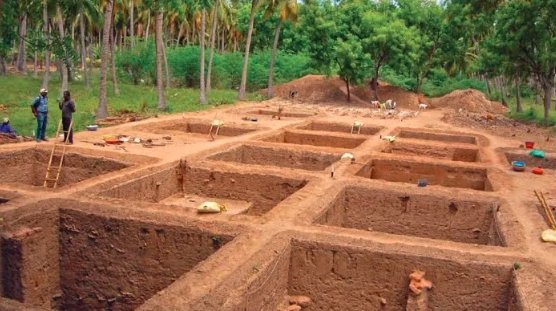In a groundbreaking discovery, archaeologists have unearthed a 2,600-year-old water management system in Keeladi, Tamil Nadu. This ancient terracotta pipeline, found during the 10th phase of excavations, highlights the advanced engineering skills of the region’s early inhabitants. The discovery includes six cylindrical structures forming a long pipeline, indicating sophisticated water management practices. This finding not only sheds light on the technological prowess of ancient Tamil society but also pushes the historical timeline of urban civilization in the region.
Ingenious Water Management Techniques
The recent excavation at Keeladi has revealed a terracotta pipeline system that dates back to the 6th century B.C.E. This discovery is part of a broader effort to understand the water management practices of ancient Tamil society. The pipeline, composed of six neatly fitted cylindrical structures, measures approximately 174 cm in length. Each cylinder is about 14 inches long and seven inches wide, showcasing the precision and skill of the ancient engineers.
The pipeline’s design suggests it was used to transport fresh water, possibly for domestic or agricultural purposes. This discovery is significant as it provides concrete evidence of the advanced water management techniques employed by the inhabitants of Keeladi. The presence of such a system indicates a well-organized society with a deep understanding of hydraulic engineering.

Further excavations are expected to reveal more about the extent and complexity of this ancient water management system. Researchers believe that studying these structures will offer valuable insights into the daily lives and technological capabilities of the people who lived in Keeladi over two millennia ago.
Historical Significance of Keeladi
Keeladi, located approximately seven miles southeast of Madurai, has been a focal point of archaeological research since its discovery in 2014. The site has yielded over 20,000 artifacts, providing a wealth of information about the region’s ancient inhabitants. The recent discovery of the terracotta pipeline adds to the growing body of evidence that Keeladi was a thriving urban settlement with advanced infrastructure.
The artifacts recovered from Keeladi suggest that the site was an industrial hub, with evidence of brickmaking, bead production, and terracotta manufacturing. The discovery of the pipeline further supports the notion that the inhabitants of Keeladi had developed sophisticated technologies to support their urban lifestyle. This finding also aligns with previous discoveries of open drains, closed channels, and small tanks, indicating a comprehensive water management system.
The ongoing excavations at Keeladi aim to rewrite the history of ancient Tamil society by providing scientific evidence of its advanced technological and industrial capabilities. The discoveries made at this site continue to challenge existing historical narratives and offer new perspectives on the development of urban civilization in southern India.
Implications for Future Research
The discovery of the ancient pipeline at Keeladi has significant implications for future archaeological research in the region. It highlights the need for continued exploration and study of ancient water management systems to better understand the technological advancements of early civilizations. The findings at Keeladi also underscore the importance of preserving and protecting archaeological sites to ensure that valuable historical information is not lost.
Researchers are now focusing on uncovering more details about the pipeline and its role in the daily lives of Keeladi’s inhabitants. By analyzing the materials and construction techniques used in the pipeline, archaeologists hope to gain a deeper understanding of the technological innovations of the time. This research will contribute to a broader understanding of the development of urban infrastructure in ancient Tamil society.
The Keeladi excavation project serves as a reminder of the rich cultural heritage of Tamil Nadu and the importance of preserving it for future generations. As more discoveries are made, the historical significance of Keeladi will continue to grow, offering new insights into the lives and achievements of ancient Tamil people.














